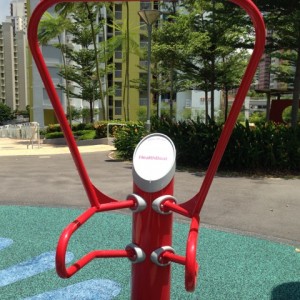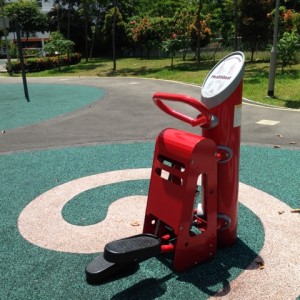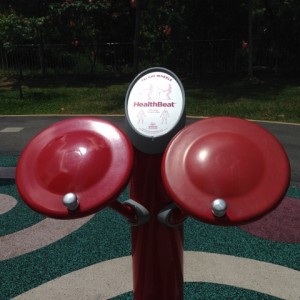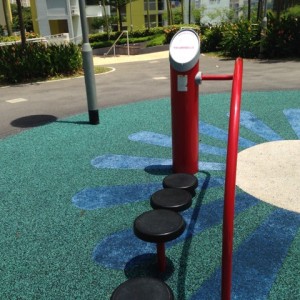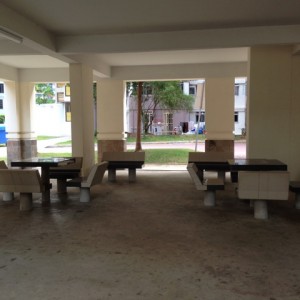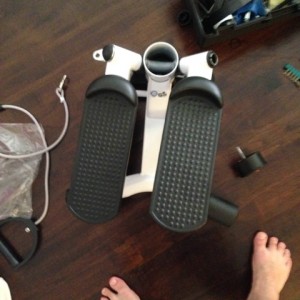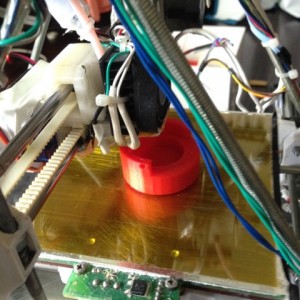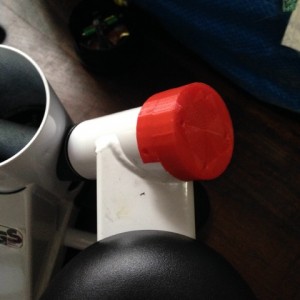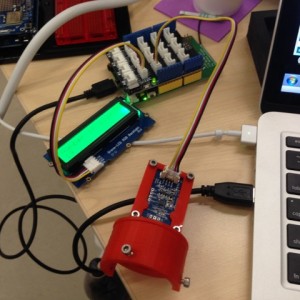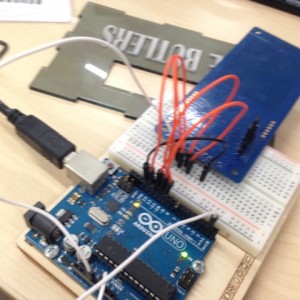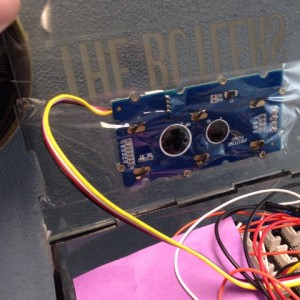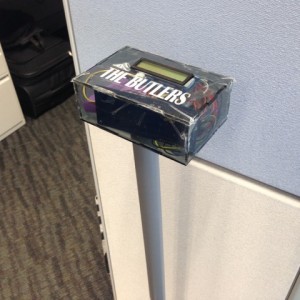My first hackathon was in April. It was fantastic experience. We came up with a cool product (1st Runner up!) and I also got to learn a lot, not just technical skills but also about how to approach product development and working in a technical team. I’m going to write two posts about the hackathon. This post describes what we made, the next one will talk about my learning points.
“Hacking the internet of things”
The hackathon was the Singapore IOT Hackathon 2015. The goal was to develop an application of the MediaTek Linkit ONE development board targeted at either Healthcare, Geriatrics or Construction. As well as using the Linkit ONE all the teams had to incorporate a 9 DOF Inertial Measurement Unit (a combined accelerometer /gyroscope /magnetometer) into the product. Teams were limited to five people and had to include a mix of electronics and web development skills. The hackathon ran for just over 24 hours, but teams were allowed to do preparation work beforehand.
This hackathon really appealed to me because it had more of a hardware focus and so used some of the skills I’ve developed from the projects on this blog. Unfortunately I was a person (in fact, I still am), not a team, so I couldn’t participate until I found someone to work with.
My approach to this challenge was to head to the hackathon information session, find a team with less than four people and beg to be included. I found a fantastic team from the Image and Pervasive Access Lab who were very welcoming. Between them they had all the skills they needed already, but they were much stronger on the web side than the hardware/electronics side. This fortunate situation meant I could wheedle a position helping out on the hardware.
Top Uncle
The IPAL team had already decided to focus on geriatrics as they had a lot of experience in that area. However, they still needed to decide on a specific application. We did some brainstorming and came up with a focus on a uniquely Singaporean phenomenon, the “fitness corner”.
Most people in Singapore live in public housing developments called HDB estates. The estates are usually extremely well thought out and have lots of amenities such as convenience stores and food courts. They also have fitness corners, which are like public access outdoor gyms. As well as static equipment such as pull up bars they also have stationary bikes, step machines and other types of dynamic equipment. The equipment isn’t electronic like the stuff you get in normal gyms. Instead its purely mechanical and is designed to be rugged enough to put up with public outdoor use.
One of the goals for these fitness corners is to keep senior citizens active and healthy. However, you don’t often see that many senior citizens using the equipment. The idea behind our product was to increase the attractiveness of these fitness corners to seniors by making them more interesting and enjoyable. Increasing seniors’ usage of the fitness corner facilities would have the dual benefits of helping them keep fit and to help them connect socially with other seniors in the area.
We did this by creating a device that can be retrofitted to existing fitness corner machines to connect them to the internet. Individual users can identify themselves to the machine using a RFID card such as their public transport pass. The machine will then log their workout for them and then use this information to support features such as a leaderboard for people using the machines, friendly competitions and awards for reaching different activity levels.
My favourite feature is the leaderboard, which was designed in a 80’s arcade style. In Singapore the word “Uncle” is often used as a respectful way to refer to any older male, not just the brothers of your parents. The leaderboard was reminiscent of reality shows like America’s Next Top Model, so we decided to call this feature “Top Uncle” (or Top Auntie). The idea would be to display the leaderboard at the bottom floors of HDB blocks so that residents could see how they were doing versus rival Aunties/Uncles in the estate.
The Butler
Since it would have been difficult to bring the hackathon judges to a fitness corner, we decided to build a prototype based on a home fitness stepping machine. When the user goes up to the machine they see a small LCD panel asking them to tap their RFID card. Once they do this they can start their workout and the screen shows them how many steps they’ve done while simultaneously transmitting the performance information to a server. The server uses the stepper data to update a website with all kinds of beautiful features such as a leaderboard and social features.
The device is called “the Butler” for inside joke reasons. From a hardware perspective it is made up of:
- MediaTek Linkit ONE board: does almost all the thinking on the client side. It includes a built in wifi adapter which it uses to connect to the internet (the board can also do 3G, which would be more realistic for a real world deployment)
- 9 DOF Inertial Measurement Unit: measures the motion of the stepper. For the prototype it uses the current direction of gravity to work out what angle the stepper plate is at
- LCD screen with colour backlighting: shows messages to the user as well as the number of steps. The background colour changes based on what state the machine is in
- RFID reader: detects when a RFID card has been tapped on the reader
- Arduino Uno: we couldn’t get the RFID reader to work with the Linkit, so the Uno talks to the RFID reader and then gives a signal to the main board
- Various 3D printed fixings: the IMU was attached to the stepper with a custom 3D printed mount, and we used another custom 3D printed fixing to connect the pole to the stepper
- Laser cut acrylic box: to hold all the electronics and to show a nifty laser etched “The Butlers” logo
- A big piece of PVC pipe: to connect the electronics box to the stepper
The prototype was only part of the competition, we also had to pitch it to the judges. It was a challenging pitch because it had a very tight time limit – only 3 minutes. Getting across the idea in a compelling way in that period of time was really tough. Fortunately one of our team members dedicated himself to the pitch and was able to give a very crisp description of the product. He is also a physiotherapist so he was able to talk credibly about the importance of exercise for seniors.

During the pitch we went for a live demonstration of the prototype using one of the judges as our test user. This approach had its risks as the stepper we bought swayed side to side as well as going up and down. There was no handle, so we had to mitigate the danger of the judge falling off and injuring themselves by placing a team member close enough to act as a kind of human crash bag if the worst occurred.
Judgement of the Butler’s service
The winning team was a smart shoe that shows how you are applying pressure to different parts of your foot as you walk, we came in as the first runner up. We came in as first runner up. I was very proud of what we were able to accomplish in 24 bleary, sleep-deprived hours. You can see a picture of the team early on in the hackathon at the IPAL write up. Fortunately there aren’t many photographs of how we looked after a night of sweaty coding.
Winning a prize was a bonus on top of the general feeling of building something and the great learning opportunities from the experience. I’ll write more about what I learned in the next post.


